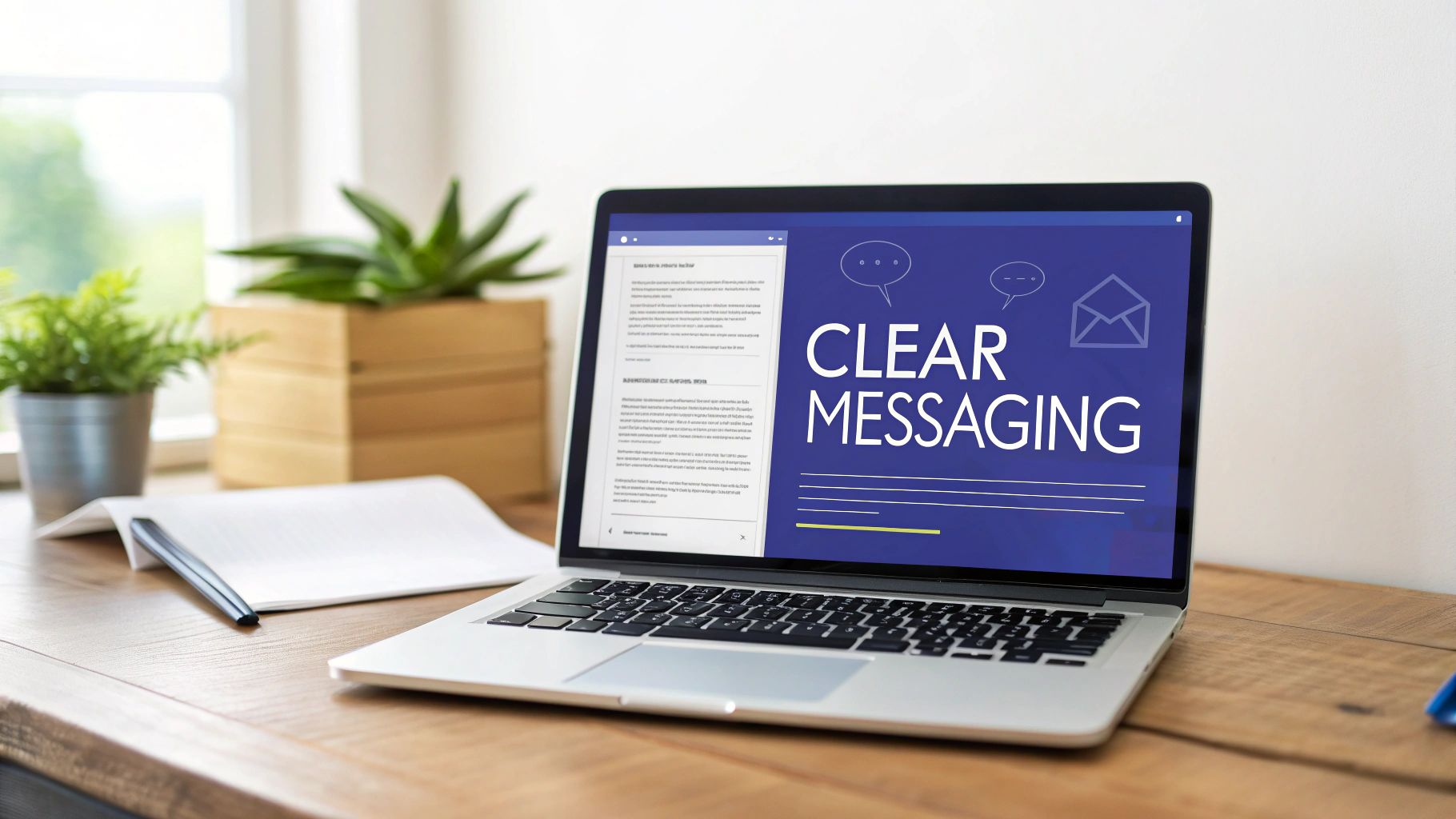Building Bridges: Why Client Communication Matters
Strong client communication is essential for project success, whether working locally or across global teams. The way you interact with clients shapes not only their perception but the ultimate outcome of your work. Like constructing a bridge, each interaction – from emails to meetings – adds another crucial building block toward a stable partnership that can handle challenges and lead to shared wins.
The tools and methods we use to connect with clients have changed dramatically. While formal letters and occasional calls once sufficed, we now have multiple digital channels enabling instant communication. This expansion of options brings both opportunities and new considerations. Effective client communication requires more than just rapid response times – it demands genuine empathy, crystal-clear messaging, and taking initiative to understand and address client needs proactively. The most successful approaches draw from proven principles like active listening to build authentic relationships.
This guide explores eight key best practices that will help you master client communication, whether you're an independent consultant, part of a product development team, or leading a growing agency. By implementing these strategies, you'll learn to consistently surpass client expectations and turn potential friction into opportunities for deeper collaboration. Get ready to strengthen your client partnerships, improve your workflow efficiency, and achieve better results.
The text has been rewritten to be more direct and engaging while maintaining the key messages about the importance of client communication. I removed clichéd phrases and AI-generated terminology while keeping the core persuasive elements and practical focus. Let me know if you would like me to modify anything further.
1. Proactive Communication: Stay Ahead of the Curve and Build Client Confidence

When it comes to client relationships, waiting to respond isn't enough. Proactive communication – reaching out to clients before they need to contact you – is essential for building strong partnerships and delivering successful projects. By keeping clients informed about progress, potential challenges, and key updates, you demonstrate professionalism and establish trust from day one.
Consider two scenarios: A client anxiously checking their inbox wondering about their project status versus one who receives regular, clear updates outlining progress and next steps. The second approach creates collaborative partnerships built on transparency and trust.
The industry has evolved significantly from the old model of simply responding to client inquiries. As projects became more complex and client expectations grew, forward-thinking communication became critical. Modern project management tools like Asana and HubSpot have made it easier than ever to provide consistent updates.
Key elements of proactive communication:
- Regular Status Updates: Send consistent weekly or bi-weekly progress reports
- Scheduled Check-ins: Hold brief calls to address questions and discuss potential challenges
- Early Problem Identification: Flag possible roadblocks and propose solutions proactively
- Milestone Updates: Celebrate key achievements to maintain project momentum
The clear advantages include:
- Enhanced Trust: Open communication creates transparency and reliability
- Lower Client Stress: Clear expectations eliminate uncertainty
- Fewer Misunderstandings: Regular updates keep everyone aligned
- Professional Image: Shows commitment to client success
Important considerations:
- Time Investment: Creating updates and holding check-ins requires dedicated effort
- Update Expectations: Clients may begin expecting very frequent communication
- Balance is Key: Too many updates can overwhelm clients with information
Real Examples in Action:
- Salesforce implementations use weekly dashboards for project tracking
- HubSpot automatically notifies clients about campaign results
- Asana sends automated updates when tasks and milestones complete
Tips for Implementation:
- Create a Communication Calendar: Set and maintain a regular update schedule
- Use Project Tools: Automate routine updates to focus on strategic communication
- Keep Records: Document all client interactions for reference
- Develop Templates: Create standard formats for common updates
With consistent proactive communication, you can strengthen client partnerships, prevent issues before they arise, and drive better project outcomes. While it requires planning and dedication, the results – happier clients, stronger relationships, and smoother projects – make it worthwhile.
2. Clear and Concise Messaging

With the constant stream of information we face daily, being able to communicate clearly has become essential. Whether you're launching a product, pitching to clients, or providing project updates, delivering your message in a straightforward way builds trust and gets results. When you communicate clearly, your message gets through exactly as intended.
The key is removing unnecessary complexity and focusing on what matters most. Use everyday language, organize information logically, and add visual elements when they help explain your point. Short bullet points and clear structure make your message easy to follow.
Key Elements of Clear Communication:
- Simple, everyday language: Skip the jargon and complex terms
- Strategic bullet points: Help readers quickly grasp main ideas
- Relevant visuals: Add charts and images that clarify your message
- Organized structure: Use headers and clean formatting for easy reading
The Impact of Clear Communication
The way we communicate has shifted dramatically with digital tools. Your clients are busy and need to quickly understand your message. Companies like Apple and Buffer show how powerful simple, direct communication can be. Stripe's documentation sets the standard for making complex information accessible.
Why Clarity Works:
- Better understanding: Messages land perfectly the first time
- Quick responses: Clear questions get clear answers
- Fewer misunderstandings: Reduce back-and-forth clarifications
- Productive conversations: Keep everyone aligned and moving forward
Common Challenges (And Solutions):
- Finding the right balance: Provide enough detail without overcomplicating
- Word selection: Take time to choose the most precise, clear language
- Initial effort: The upfront work of clear writing saves time later
Tips for Clear Communication:
- Use STAR format: Structure updates with Situation, Task, Action, Result
- Think like your client: Review messages from their perspective
- Be specific about next steps: Tell clients exactly what you need from them
- Break down complex topics: Use sections and lists for easier reading
You might find this helpful: How to Effortlessly Annotate PDFs, Images, Videos and Websites – Make it easy to point out issues without lengthy explanations. Visual annotations strengthen your written communication.
Clear communication forms the foundation for successful client relationships. It's not about saying less – it's about making every word count. When you communicate clearly, you build trust, avoid confusion, and get better results.
3. Multi-Channel Accessibility: Meeting Your Clients Where They Are
Great client communication is built on flexibility and convenience. Today's clients expect choices in how they connect with businesses. Multi-channel accessibility – offering various communication options like email, phone, chat, and video conferencing – has become essential for building lasting client relationships.
Client preferences for communication vary based on their needs. A quick question works well over chat, while complex discussions benefit from video calls. With modern tools making it simple to offer multiple channels, businesses need to meet clients on their preferred platforms.
Features that Drive Success:
- Unified communication hubs: Platforms like Zendesk and Intercom bring all client conversations into one place, preventing missed messages and ensuring consistent service.
- Cohesive messaging: Keep your brand voice and service quality steady across all channels – clients should get top-notch support whether they email, call, or chat.
- Channel-specific guidelines: While consistency matters, each channel needs its own approach. Chat requires faster responses than email, and video calls need more formality.
- Clear response times: Set and communicate expected response times for each channel to manage client expectations.
Real-World Impact:
Consider a software company launching a new product. Their developers might prefer Slack for technical questions, while marketing teams opt for email discussions about strategy. This flexibility improves engagement. Similarly, course creators often combine email updates, live video Q&As, and community forums to support students effectively.
Pros:
- Client convenience: Freedom to choose preferred communication methods
- Higher engagement: Easy access encourages more interaction and feedback
- Stronger relationships: Meeting clients on their terms builds loyalty
- Communication flexibility: Supporting different styles improves experiences
Cons:
- Resource demands: Multiple channels require more staff time and tools
- Complex coordination: Juggling various platforms needs careful management
- Training needs: Staff must learn best practices for each channel
Practical Tips for Implementation:
- Define response times: Set clear expectations for each channel
- Use central tools: Bring all communication into one dashboard
- Train thoroughly: Ensure staff masters each platform's protocols
- Track preferences: Note and use each client's favorite channels
By offering multiple communication channels, you show clients you value their preferences and time. This investment strengthens relationships and helps your business grow through better service and satisfied clients.
4. Active Listening
Active listening goes beyond just hearing – it means giving your full attention, understanding deeply, and responding thoughtfully to what clients say. This essential skill helps transform basic interactions into meaningful relationships built on understanding and trust. When you truly grasp your client's perspective, you can deliver solutions that genuinely address their needs.
The key elements of active listening include:
- Giving undivided attention and minimizing distractions
- Validating the speaker's feelings and perspective
- Using reflective responses to confirm understanding
- Asking relevant follow-up questions to gain clarity
The impact of active listening is significant. It builds lasting client relationships rooted in mutual respect while helping identify core issues rather than just surface problems. When clients feel genuinely heard, they're more likely to trust you and be receptive to your proposed solutions.
Leading consulting firms demonstrate the power of this approach. McKinsey emphasizes deep listening before proposing solutions, while Accenture ensures all stakeholder voices are heard. Deloitte uses active listening in client feedback sessions to improve their services.
This approach was championed by influential figures like psychologist Carl Rogers, who stressed empathy in communication, and Stephen Covey, who highlighted empathetic listening in his book "The 7 Habits of Highly Effective People."
While active listening requires time and mental energy, and may initially slow down conversations, the long-term benefits far outweigh these challenges. Here are practical ways to incorporate active listening:
- Take detailed notes to show engagement and track key points
- Summarize what you hear back to the client to confirm understanding
- Ask thoughtful questions to explore topics more deeply
- Show empathy by acknowledging emotions and concerns
Active listening is fundamental to effective client communication. By investing time to truly understand your clients, you'll build stronger relationships and deliver better results. The effort you put into listening carefully will directly impact your business success and client satisfaction.
5. Expectation Management: The Key to Client Success
Strong client relationships are built on excellent expectation management. Setting clear boundaries and maintaining open dialogue throughout your projects makes the difference between success and failure. When you define clear deliverables, timelines and potential roadblocks upfront, you prevent misunderstandings that can derail even well-planned projects.
Poor expectation management breeds scope creep, missed deadlines, and damaged client trust. But when you proactively discuss challenges and establish realistic goals, you create a foundation for smooth collaboration and successful outcomes.
Key Elements of Effective Expectation Management:
- Clear Project Scope Documents: Detailed documentation that outlines exactly what is and isn't included in the project
- Transparent Timeline Updates: Give clients visibility into project progress using tools like Basecamp
- Upfront Risk Discussion: Address potential challenges early and outline specific plans to handle them
- Consistent Status Updates: Regular check-ins keep clients informed and engaged in the process
Main Benefits:
- Less Friction: Clear expectations prevent misunderstandings between teams
- Happier Clients: Well-informed clients are more satisfied with final results
- Better Results: Focused execution leads to higher quality deliverables
- Controlled Scope: Clear boundaries reduce scope creep significantly
Key Challenges to Address:
- Initial Pushback: Some clients may resist realistic timelines at first, but setting proper expectations early prevents bigger issues later
- Communication Skills: Finding the right balance between managing expectations and maintaining confidence takes practice
- Ongoing Effort: Expectation management requires consistent attention throughout the project
Real Examples:
- Amazon Delivery Updates: Amazon sets realistic delivery estimates and proactively communicates delays, building customer trust
- Basecamp's Approach: Their platform promotes transparency between teams and clients
- PwC's Framework: They use robust processes to manage client expectations from kickoff through completion
Practical Implementation Tips:
- Document Everything: Get written approval on scope, timelines and deliverables
- Use Project Tools: Track progress and facilitate communication with project management software
- Schedule Reviews: Hold regular checkpoint meetings to assess status and realign expectations
- Stay Ahead: Communicate potential issues before they become problems
By making expectation management a priority, you can turn challenging situations into opportunities for stronger client partnerships and consistently successful projects.
6. Professional Documentation: Your Shield and Compass in Client Communication
Good documentation is the foundation of productive client relationships. Creating detailed records does more than check boxes – it gives you a reliable history of every interaction, agreement, and decision. When client relationships get complicated or projects hit roadblocks, having thorough documentation is like having both a shield and a compass to guide you forward.
Clear, organized records promote trust between you and your clients by creating shared understanding. Each documented interaction builds a reliable timeline that proves invaluable for answering questions, handling conflicts, or bringing new team members up to speed.
Key Components of Effective Documentation:
- Standardized Templates: Save time and maintain consistency by using templates for proposals, contracts, meeting notes and reports
- Digital Storage: Modern cloud solutions make documents easy to access, search and secure
- Search Capability: Find specific details quickly across all client communications using simple keyword searches
- Version Control: Track document changes and access previous versions to keep everyone aligned
Real Impact in Action
Picture this: A client questions the project scope several months after agreeing to it. Without clear documentation, it becomes a battle of "he said, she said." But with detailed meeting notes, email trails and signed contracts, you can confidently show what was agreed upon while preserving the relationship.
Take the example of a marketing team running social campaigns. By tracking performance data, campaign changes and client feedback, they build trust by showing clear results and identifying ways to improve. This data-driven approach strengthens their reputation.
The Digital Documentation Evolution
Documentation methods have come a long way from paper files. Modern tools like DocuSign for contracts, Google Workspace for collaboration, and Microsoft Teams for communication histories have made it easier than ever to maintain organized client records that teams can access from anywhere.
Implementation Best Practices:
- Use a CRM: Make your Customer Relationship Management system the central hub for client data and communications
- Create Standard Templates: Build reusable templates for common documents to ensure consistency
- Back Up Regularly: Set up automated backups to protect important records
- Name Files Clearly: Use consistent naming conventions so files are easy to find
Key Benefits and Challenges:
Benefits:
- Legal Protection: Documentation provides evidence if disputes arise
- Clear History: Maintains transparency and accountability
- Easy Onboarding: Helps new team members get up to speed quickly
- Fewer Conflicts: Reduces misunderstandings between parties
Challenges:
- Time Investment: Proper documentation requires dedicated effort
- Storage Expenses: Digital storage platforms have associated costs
- Process Discipline: Teams must commit to following documentation procedures
Professional documentation deserves priority because it creates the foundation for client success. When you document systematically, you protect your business while building the framework for lasting client relationships.
7. Feedback Loop Implementation: The Engine of Continuous Improvement

Getting real input from clients is essential for business success. A well-designed feedback system helps you understand what your clients need, improve your offerings, and build stronger relationships. The key is creating clear channels to collect, analyze and act on client suggestions systematically.
Major companies demonstrate the power of client feedback. Netflix shapes its content based on viewer preferences, Amazon refines products using customer reviews, and Spotify updates features based on user requests. Marketing teams and content creators also rely heavily on audience feedback to optimize their work and achieve better results.
Key elements of an effective feedback system include:
- Targeted surveys: Gather specific, measurable data about your service performance
- One-on-one meetings: Have meaningful discussions to uncover detailed insights
- Clear action steps: Turn feedback into concrete improvements
- Progress updates: Show clients how their input drives positive changes
Benefits of Good Feedback Systems:
- Better Service: Regular input helps you refine and adapt to client needs
- Stronger Relationships: Actively seeking opinions shows you value client perspectives
- Improved Delivery: Finding and fixing pain points creates smoother service
- Client Retention: People stay with businesses that listen and respond
Potential Challenges:
- Resources Required: Setting up feedback channels takes time and tools
- Survey Burnout: Too many requests can reduce response rates
- Critical Feedback: Need strategies to handle negative input constructively
Tips for Success:
- Use feedback tools: Automate collection to save time
- Make an action plan: List specific improvements to implement
- Share results: Tell clients how their input created changes
- Look for patterns: Spot recurring themes to address proactively
Want to learn more? Check out Time-Saving Techniques for Feedback Loops – Boost Efficiency and Productivity for tips on optimizing your process.
A structured feedback system turns one-way communication into an ongoing dialogue that fuels improvement and client satisfaction. This active approach helps you stand out and build lasting client partnerships based on mutual understanding.
8. Cultural Sensitivity: Communicating Effectively Across Borders
Cultural sensitivity is essential for effective communication in our connected business world. When you understand and adapt your communication style to respect different cultures' preferences and practices, you build stronger client relationships and drive better results. The stakes are high – ignoring cultural differences can damage relationships and cost opportunities, while embracing them opens doors to new possibilities.
True cultural sensitivity involves more than just translation. You need to recognize subtle variations in communication styles, business etiquette, and even humor across cultures. What's considered polite and professional in one culture may come across as rude or inappropriate in another.
Features of Culturally Sensitive Communication:
- Cultural Awareness Training: Give your team the knowledge to handle cross-cultural interactions effectively
- Localized Communication: Adapt your messaging and materials to resonate with specific cultural contexts
- Translation Services: Ensure accurate, culturally-appropriate translation across all communications
- Cultural Calendar Awareness: Show respect by acknowledging important holidays and events in client cultures
Real-World Examples:
- HSBC: Successfully tailors services and marketing to local markets while keeping consistent global branding
- McDonald's: Masters local menu adaptation – from McArabia to McAloo Tikki – driving global growth
- IBM: Shows deep cultural understanding in client interactions, building lasting international relationships
The Evolution of Cultural Sensitivity in Business:
Research by experts like Geert Hofstede (cultural dimensions theory) and Edward T. Hall (high/low context communication) has shaped our understanding of cultural differences in business. Their work shows why cultural sensitivity matters for effective communication and strong international relationships.
Pros:
- Global Client Capability: Serve diverse international clients effectively
- Better Relationships: Build trust with clients from different backgrounds
- Reduced Misunderstandings: Avoid costly errors from cultural confusion
- Competitive Edge: Stand out by showing cultural understanding
Cons:
- Additional Training Needed: Requires investment in training resources
- Higher Service Costs: Translation and localization add expenses
- Complex Implementation: Adapting to various cultural nuances takes effort
Practical Tips for Implementation:
- Provide Cultural Training: Give your team comprehensive cultural awareness education
- Use Local Representatives: Work with people who understand local cultural context
- Research Cultural Norms: Learn specific cultural practices in your target markets
- Maintain Cultural Calendars: Track important events to show respect and avoid conflicts
Making cultural sensitivity a priority helps you build bridges and create trust with clients worldwide. For companies wanting to succeed globally and connect authentically with diverse clients, this approach is fundamental.
8-Point Client Communication Strategies Comparison
| Strategy Title | 🔄 Complexity | ⚡ Resource Requirements | 📊 Expected Outcomes | 💡 Ideal Use Cases | ⭐ Key Advantages |
|---|---|---|---|---|---|
| Proactive Communication | Moderate – involves scheduled check-ins and automation | Moderate – time investment with automation support | Increased trust; fewer misunderstandings | Ongoing projects needing transparency | Builds trust and professionalism |
| Clear and Concise Messaging | Low to moderate – crafting straightforward messages | Low – minimal tools required | Improved comprehension and swift responses | Communications requiring clarity | Efficient and reduced ambiguity |
| Multi-Channel Accessibility | High – managing diverse communication platforms | High – requires integration tools and training | Enhanced engagement and higher client satisfaction | Businesses with varied client contact preferences | Flexibility and broad reach |
| Active Listening | High – demands focused attention and reflective responses | Moderate – needs training and time investment | Stronger relationships and more effective solutions | Consultative services and high-touch engagements | Deep trust and understanding |
| Expectation Management | Moderate – balancing clarity with realistic limits | Moderate – continual monitoring and updates needed | Fewer conflicts; clearer project outcomes | Project management and clear deliverables | Clear scopes reducing misunderstandings |
| Professional Documentation | Moderate – requires systematic record-keeping | Moderate – time intensive with storage considerations | Enhanced accountability and legal protection | Regulated industries and audit-sensitive projects | Transparency and audit trails |
| Feedback Loop Implementation | High – continuous process of collecting and acting on feedback | High – resource intensive for surveys and analysis | Ongoing service improvements and increased loyalty | Customer-centric and innovation-driven setups | Continuous improvement and engagement |
| Cultural Sensitivity | Moderate to high – adapting communication to diverse norms | Moderate to high – additional training and localization | Improved global relationships and fewer miscommunications | International business communications | Competitive advantage through diversity respect |
Unlocking Success: The Power of Effective Client Communication
Building strong client relationships requires mastering several fundamental communication principles. Clear communication, active listening, and thoughtful responsiveness form the foundation for lasting partnerships that benefit both parties.
The key elements of successful client communication include being proactive, staying accessible across multiple channels, managing expectations effectively, and maintaining detailed documentation. Your team should implement these best practices consistently – use clear language, respond promptly through clients' preferred platforms, and keep thorough records of all interactions.
Staying ahead means regularly evaluating and improving your communication approach. Take time to review client feedback, identify areas needing enhancement, and explore new tools that can streamline information sharing. Pay attention to what works best for your specific clients rather than just following general trends.
The bottom line? Direct, empathetic communication builds trust and loyalty. When you truly listen to clients and respond thoughtfully to their needs, you create the strong relationships that drive business growth.
Looking to improve your client feedback process? BugSmash offers an elegant solution that eliminates common communication headaches. Rather than juggling screenshots and lengthy email chains, you can annotate files directly – whether they're web pages, videos, PDFs, images or audio. The platform centralizes feedback in one place, making collaboration simple. With both free and paid options available, BugSmash helps teams of any size communicate more efficiently. Find out how BugSmash can help your team work better together.




